
Industrial manufacturing company Ingersoll Rand (NYSE: IR) met Wall Street’s revenue expectations in Q4 CY2024, with sales up 4.2% year on year to $1.90 billion. Its non-GAAP profit of $0.84 per share was in line with analysts’ consensus estimates.
Is now the time to buy Ingersoll Rand? Find out by accessing our full research report, it’s free.
Ingersoll Rand (IR) Q4 CY2024 Highlights:
- Revenue: $1.90 billion vs analyst estimates of $1.91 billion (4.2% year-on-year growth, in line)
- Adjusted EPS: $0.84 vs analyst estimates of $0.84 (in line)
- Adjusted EBITDA: $532.3 million vs analyst estimates of $535.3 million (28% margin, 0.6% miss)
- Adjusted EPS guidance for the upcoming financial year 2025 is $3.44 at the midpoint, missing analyst estimates by 0.7%
- EBITDA guidance for the upcoming financial year 2025 is $2.16 billion at the midpoint, below analyst estimates of $2.17 billion
- Operating Margin: 20%, up from 18.3% in the same quarter last year
- Free Cash Flow Margin: 25.9%, down from 30.3% in the same quarter last year
- Organic Revenue fell 2.8% year on year (3.8% in the same quarter last year)
- Market Capitalization: $36.82 billion
“I am proud of our global team’s strong execution and performance, driven by IRX, as we delivered double-digit earnings growth and strong free cash flow margin in 2024,” said Vicente Reynal, chairman and chief executive officer of Ingersoll Rand.
Company Overview
Started with the invention of the steam drill, Ingersoll Rand (NYSE: IR) provides mission-critical air, gas, liquid, and solid flow creation solutions.
Gas and Liquid Handling
Gas and liquid handling companies possess the technical know-how and specialized equipment to handle valuable (and sometimes dangerous) substances. Lately, water conservation and carbon capture–which requires hydrogen and other gasses as well as specialized infrastructure–have been trending up, creating new demand for products such as filters, pumps, and valves. On the other hand, gas and liquid handling companies are at the whim of economic cycles. Consumer spending and interest rates, for example, can greatly impact the industrial production that drives demand for these companies’ offerings.
Sales Growth
Reviewing a company’s long-term sales performance reveals insights into its quality. Any business can have short-term success, but a top-tier one grows for years. Regrettably, Ingersoll Rand’s sales grew at a sluggish 3.3% compounded annual growth rate over the last five years. This fell short of our benchmark for the industrials sector, but there are still things to like about Ingersoll Rand.
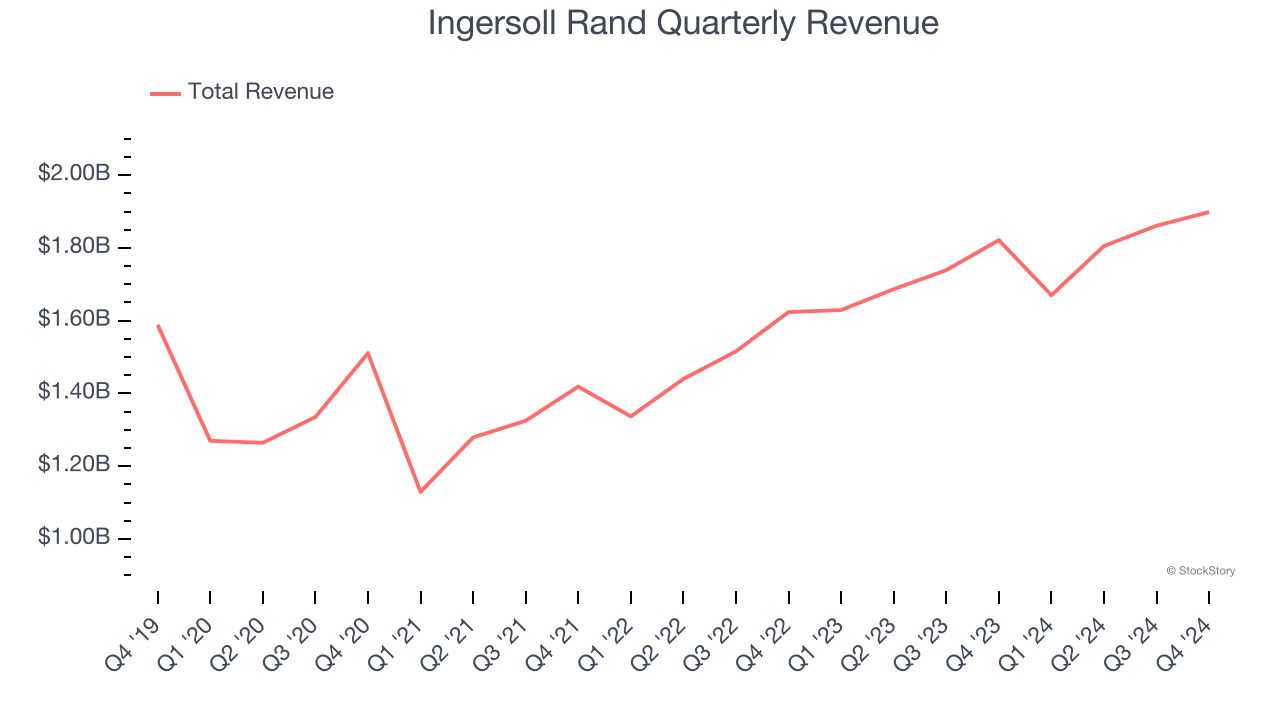
Long-term growth is the most important, but within industrials, a half-decade historical view may miss new industry trends or demand cycles. Ingersoll Rand’s annualized revenue growth of 10.6% over the last two years is above its five-year trend, suggesting its demand recently accelerated. 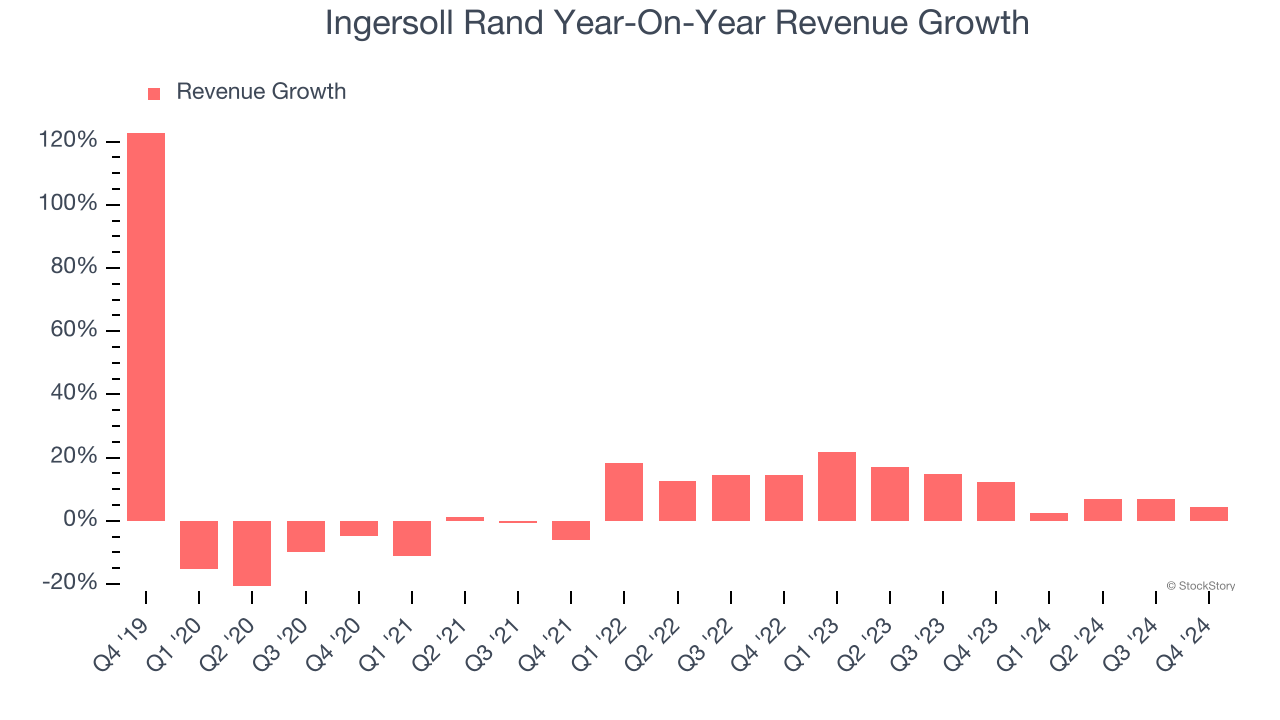
Ingersoll Rand also reports organic revenue, which strips out one-time events like acquisitions and currency fluctuations that don’t accurately reflect its fundamentals. Over the last two years, Ingersoll Rand’s organic revenue averaged 4.8% year-on-year growth. Because this number is lower than its normal revenue growth, we can see that some mixture of acquisitions and foreign exchange rates boosted its headline results. 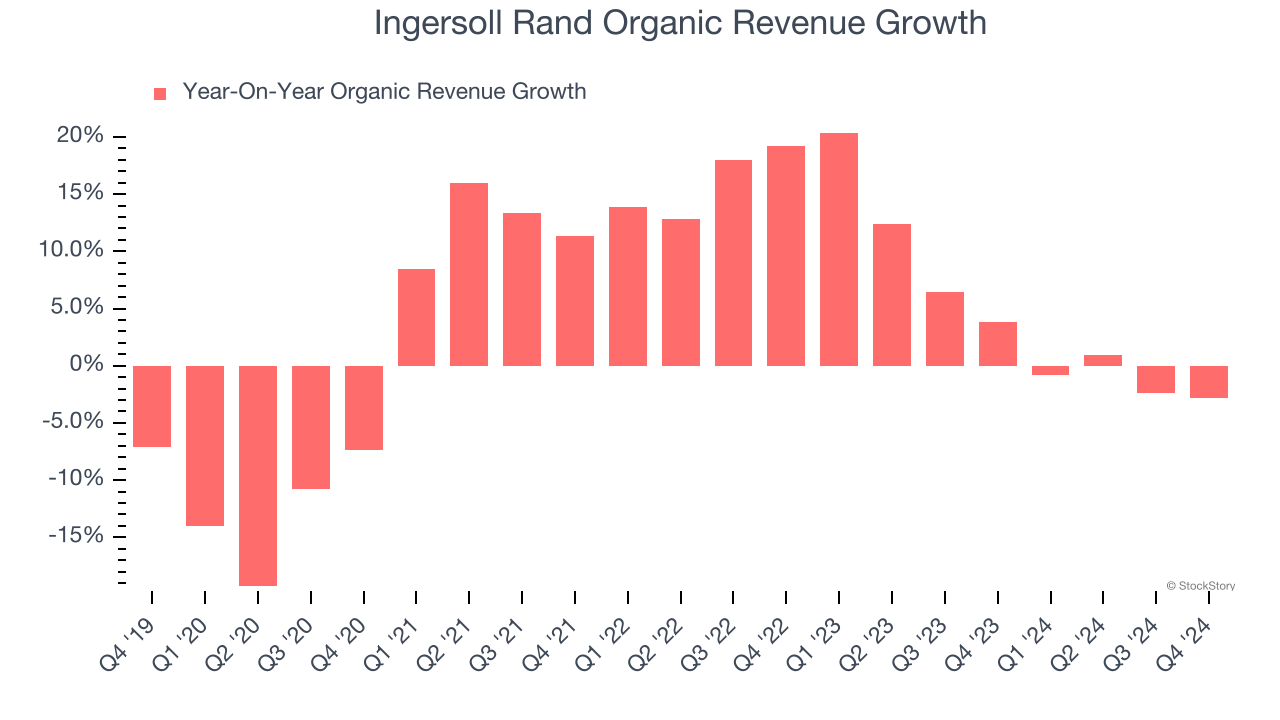
This quarter, Ingersoll Rand grew its revenue by 4.2% year on year, and its $1.90 billion of revenue was in line with Wall Street’s estimates.
Looking ahead, sell-side analysts expect revenue to grow 4.7% over the next 12 months, a deceleration versus the last two years. This projection doesn't excite us and suggests its products and services will face some demand challenges. At least the company is tracking well in other measures of financial health.
Today’s young investors won’t have read the timeless lessons in Gorilla Game: Picking Winners In High Technology because it was written more than 20 years ago when Microsoft and Apple were first establishing their supremacy. But if we apply the same principles, then enterprise software stocks leveraging their own generative AI capabilities may well be the Gorillas of the future. So, in that spirit, we are excited to present our Special Free Report on a profitable, fast-growing enterprise software stock that is already riding the automation wave and looking to catch the generative AI next.
Operating Margin
Operating margin is one of the best measures of profitability because it tells us how much money a company takes home after procuring and manufacturing its products, marketing and selling those products, and most importantly, keeping them relevant through research and development.
Ingersoll Rand has been an efficient company over the last five years. It was one of the more profitable businesses in the industrials sector, boasting an average operating margin of 12.8%. This result isn’t surprising as its high gross margin gives it a favorable starting point.
Analyzing the trend in its profitability, Ingersoll Rand’s operating margin rose by 16.8 percentage points over the last five years, showing its efficiency has meaningfully improved.
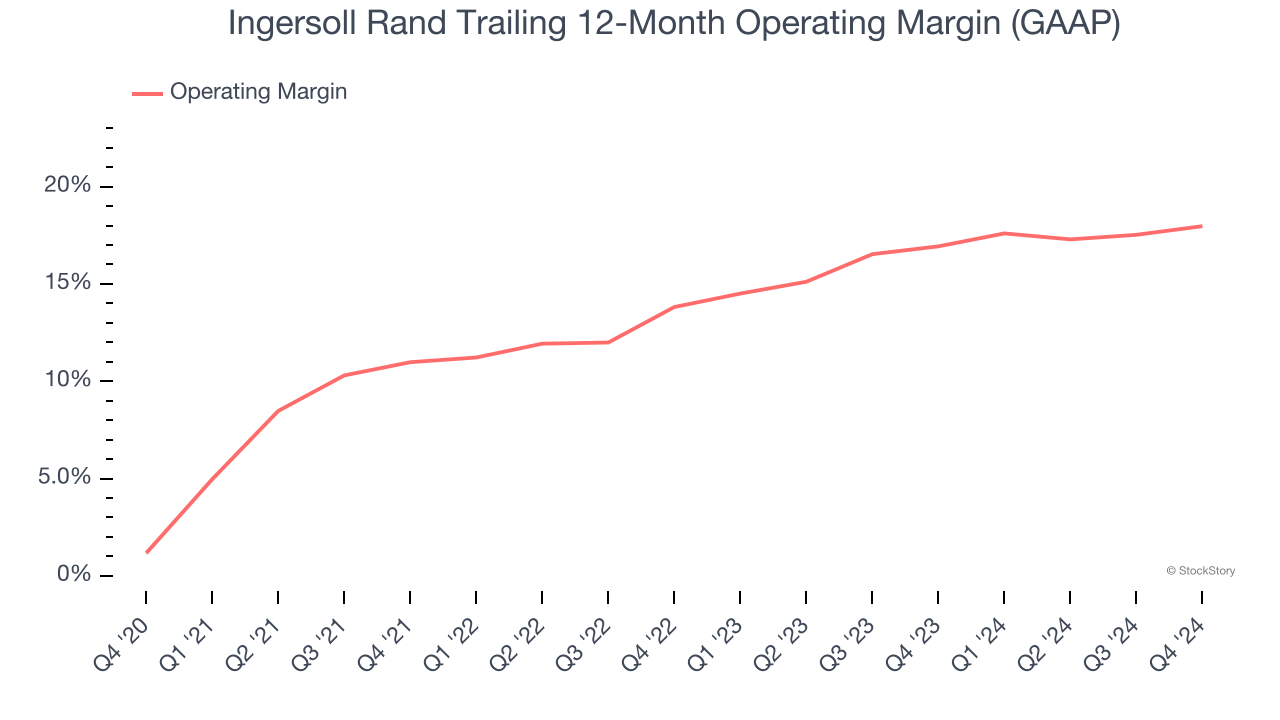
In Q4, Ingersoll Rand generated an operating profit margin of 20%, up 1.7 percentage points year on year. The increase was encouraging, and since its operating margin rose more than its gross margin, we can infer it was recently more efficient with expenses such as marketing, R&D, and administrative overhead.
Earnings Per Share
We track the long-term change in earnings per share (EPS) for the same reason as long-term revenue growth. Compared to revenue, however, EPS highlights whether a company’s growth is profitable.
Ingersoll Rand’s EPS grew at a spectacular 14.9% compounded annual growth rate over the last five years, higher than its 3.3% annualized revenue growth. This tells us the company became more profitable on a per-share basis as it expanded.
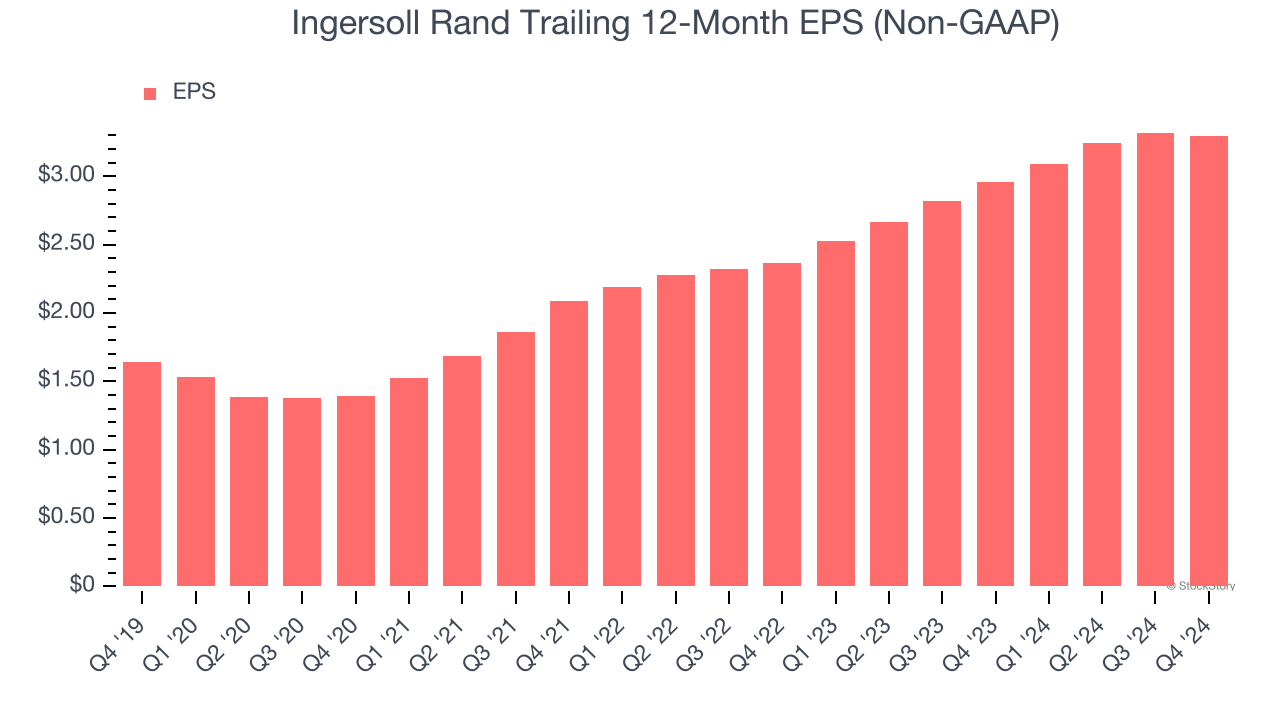
Diving into the nuances of Ingersoll Rand’s earnings can give us a better understanding of its performance. As we mentioned earlier, Ingersoll Rand’s operating margin expanded by 16.8 percentage points over the last five years. This was the most relevant factor (aside from the revenue impact) behind its higher earnings; taxes and interest expenses can also affect EPS but don’t tell us as much about a company’s fundamentals.
Like with revenue, we analyze EPS over a shorter period to see if we are missing a change in the business.
For Ingersoll Rand, its two-year annual EPS growth of 18% was higher than its five-year trend. We love it when earnings growth accelerates, especially when it accelerates off an already high base.
In Q4, Ingersoll Rand reported EPS at $0.84, down from $0.86 in the same quarter last year. This print was close to analysts’ estimates. Over the next 12 months, Wall Street expects Ingersoll Rand’s full-year EPS of $3.29 to grow 4.5%.
Key Takeaways from Ingersoll Rand’s Q4 Results
We struggled to find many positives in these results. Its organic revenue slightly missed and its revenue was in line with Wall Street’s estimates. Looking ahead, guidance largely came in below expectations. Overall, this was a softer quarter. The stock remained flat at $93 immediately after reporting.
Should you buy the stock or not? When making that decision, it’s important to consider its valuation, business qualities, as well as what has happened in the latest quarter. We cover that in our actionable full research report which you can read here, it’s free.






